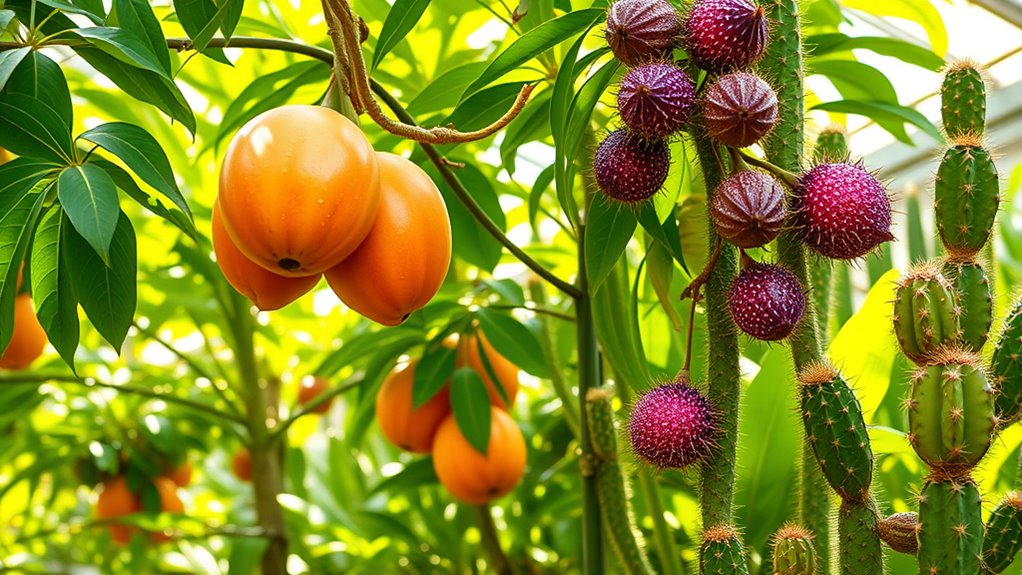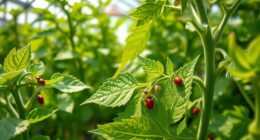To grow exotic fruits in a summer greenhouse, focus on maintaining the right soil pH, ideally between 5.5 and 7.0, by testing and adjusting with lime or sulfur. Keep pests under control through regular inspections and natural predators, and verify your plants stay healthy by creating a balanced, thriving microclimate. Proper soil and pest management are key to success; exploring these tips further will help you achieve bountiful harvests.
Key Takeaways
- Test and adjust soil pH to 5.5–7.0 for optimal nutrient absorption of exotic fruits.
- Use organic amendments like lime or sulfur to modify soil pH as needed before planting.
- Maintain a pest-free environment through regular inspection and natural predators to protect fruit quality.
- Ensure proper humidity, temperature, and soil health to create a thriving microclimate for exotic fruits.
- Implement integrated soil and pest management practices for healthy plant growth and successful harvests.

Have you ever wondered what it takes to grow exotic fruits in your own backyard? If you’re considering creating a summer greenhouse for this purpose, understanding the basics is essential. One of the most important factors is soil pH, which directly influences how well your plants absorb nutrients. Most exotic fruits thrive in slightly acidic to neutral soil, typically between pH 5.5 and 7.0. Before planting, you should test your soil to determine its current pH level. If it’s too acidic or alkaline, you can adjust it by adding amendments like lime or sulfur. Proper soil pH ensures your plants access crucial nutrients, reducing the risk of deficiencies and promoting healthy growth.
Proper soil pH is vital for thriving exotic fruits; test and adjust your soil for best growth outcomes.
Pest management is another critical aspect of successful exotic fruit cultivation. In a greenhouse environment, pests can quickly become an issue if not monitored carefully. You’ll want to regularly inspect your plants for signs of pests such as aphids, scale, or whiteflies. Keeping your greenhouse clean and free of fallen debris minimizes hiding spots for pests. Introducing beneficial insects like ladybugs or predatory mites can naturally control pest populations without relying heavily on chemical pesticides. When pest problems do occur, opt for targeted, organic solutions that won’t harm your plants or beneficial insects. Proper pest management not only safeguards your fruits but also maintains a healthy greenhouse ecosystem.
Creating the right soil conditions and managing pests effectively go hand in hand in growing exotic fruits successfully. Your choice of soil pH influences how resistant your plants are to pests and diseases. For example, healthy, balanced soil helps strengthen plant immune responses, making them less susceptible to infestations. Conversely, poor soil conditions can weaken plants, making them easier targets for pests. To keep pests at bay, you should cultivate a vigilant routine of inspection and employ integrated pest management strategies. This includes cultural practices like crop rotation, maintaining ideal humidity levels, and ensuring proper watering – all of which help prevent pest outbreaks.
Growing exotic fruits in a summer greenhouse requires attentiveness to these key factors. Adjusting soil pH ensures your plants receive the nutrients they need, while effective pest management keeps your greenhouse environment healthy and productive. Combining these practices allows you to create a thriving microclimate where exotic fruits can flourish. With patience and careful planning, you’ll soon enjoy the satisfaction of harvesting unique, delicious fruits right from your backyard. By staying proactive about soil health and pest control, you’re setting the foundation for a successful exotic fruit garden that can thrive throughout the season.
Frequently Asked Questions
Which Exotic Fruits Are Best Suited for Beginners?
For beginners, start with easy-to-grow exotic fruits like passion fruit, dwarf pomegranate, or guava. Focus on proper fruit tree selection to match your climate and space. Use soil preparation techniques such as well-draining, nutrient-rich soil and correct pH levels to guarantee healthy growth. These fruits require minimal fuss, making them ideal for newcomers. With patience and attention, you’ll enjoy fresh, unique flavors from your greenhouse harvest.
How Do I Prevent Pests in My Greenhouse?
To prevent pests in your greenhouse, start with regular greenhouse sanitation by cleaning surfaces and removing debris. Use pest control methods like introducing natural predators or applying organic insecticidal soaps. Keep an eye out for early signs of pests and isolate infected plants. Proper ventilation and maintaining ideal humidity also help deter pests. Combining these strategies ensures a healthy environment, reducing the risk of infestations and protecting your exotic fruits.
What Are the Ideal Humidity Levels for Tropical Fruits?
Did you know that most tropical fruits thrive best at humidity levels between 60-80%? For ideal humidity control, aim to keep your greenhouse within this range for the best tropical fruit care. Maintaining proper humidity prevents issues like fruit cracking or mold. Use a humidifier or misting system to adjust moisture levels as needed, ensuring your tropical fruits stay healthy, vibrant, and flavorful throughout the season.
How Often Should I Fertilize My Exotic Plants?
You should fertilize your exotic plants every 2 to 4 weeks during the growing season to maintain healthy growth. Stick to a consistent fertilizer schedule, adjusting for their specific needs, and avoid nutrient deficiencies by using a balanced, water-soluble fertilizer. During dormancy, cut back on fertilization. Regular feeding guarantees your plants get essential nutrients, promoting vibrant foliage and fruit production while preventing deficiencies.
Can I Grow Exotic Fruits Year-Round Indoors?
Yes, you can grow exotic fruit varieties year-round indoors by applying proper indoor planting techniques. Make certain your space has ample light, maintain consistent temperatures, and keep humidity levels high. Use quality soil and fertilize regularly to support healthy growth. With the right setup, your indoor environment can mimic outdoor conditions, allowing you to enjoy fresh, exotic fruits anytime, regardless of the season.
Conclusion
Imagine stepping into your summer greenhouse, where vibrant, exotic fruits flourish under your care. With patience and attention, you can transform a simple space into a tropical paradise, bursting with flavors from around the world. Don’t let the fear of the unfamiliar hold you back—embrace the adventure of growing these extraordinary fruits. After all, isn’t life too short to settle for ordinary when you can savor the extraordinary right at home?









